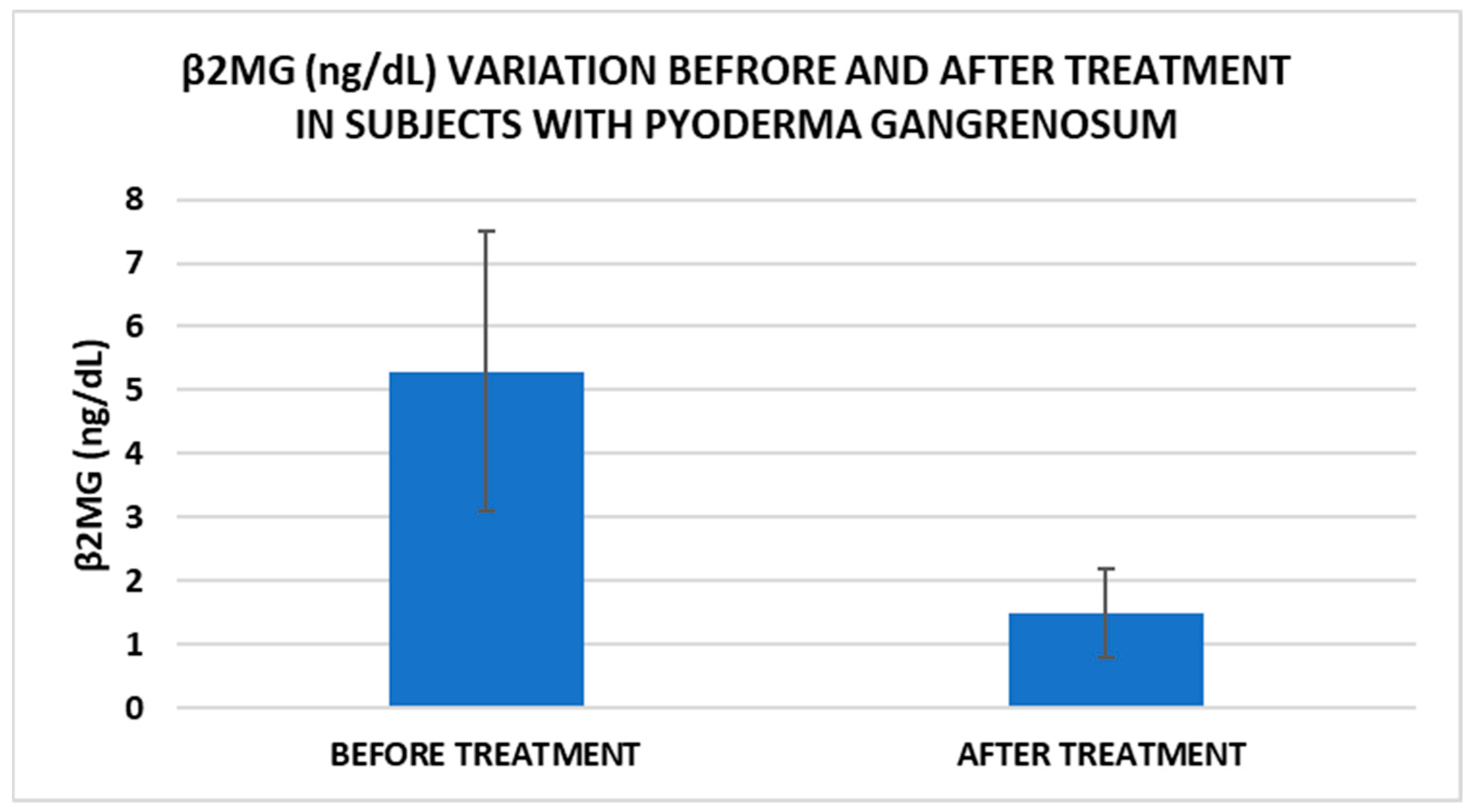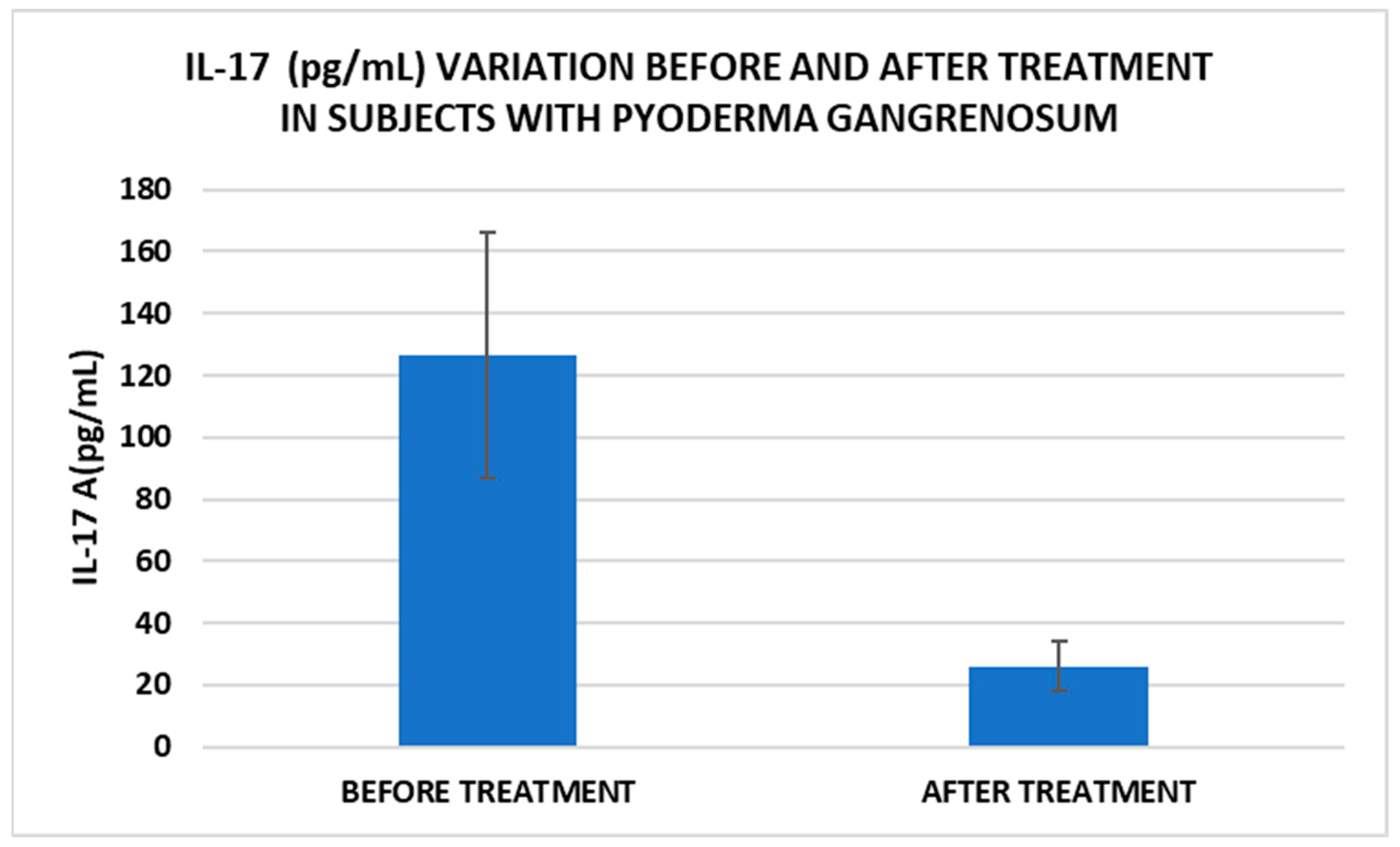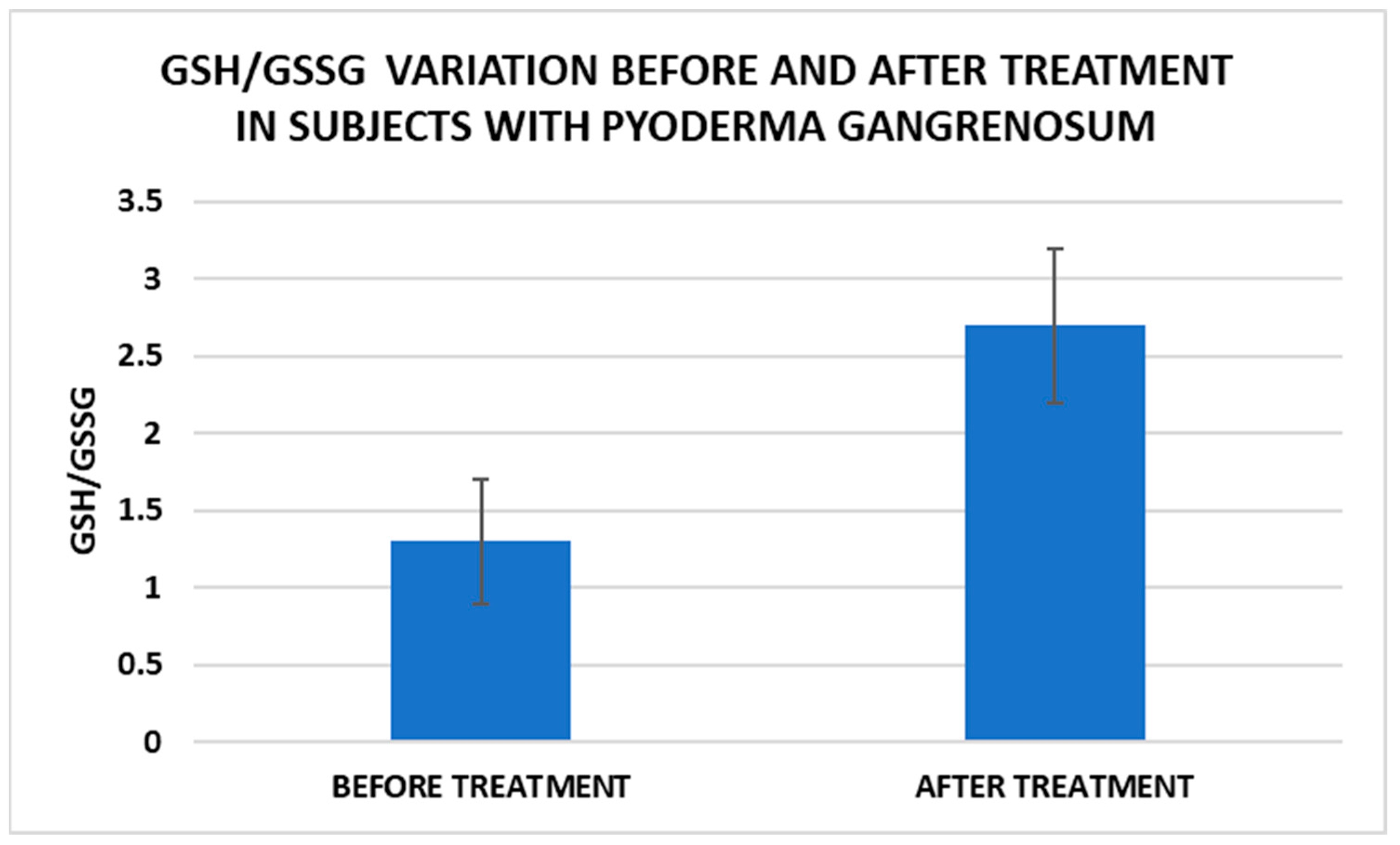Disrupted Redox Regulation and Inflammatory Response in Pyoderma Gangrenosum
Abstract
1. Introduction
2. Materials and Methods
2.1. Biological Samples
2.2. Laboratory Determinations
2.3. Statistical Analysis
3. Results
4. Discussion
5. Conclusions
Author Contributions
Funding
Institutional Review Board Statement
Informed Consent Statement
Data Availability Statement
Conflicts of Interest
References
- Hamar, P. Local Production of Acute Phase Proteins: A Defense Reaction of Cancer Cells to Injury with Focus on Fibrinogen. Int. J. Mol. Sci. 2024, 25, 3435. [Google Scholar] [CrossRef] [PubMed]
- Ene, C.-V.; Nicolae, I.; Geavlete, B.; Geavlete, P.; Ene, C.D. IL-6 Signaling Link between Inflammatory Tumor Microenvironment and Prostatic Tumorigenesis. Anal. Cell. Pathol. Amst. 2022, 2022, 5980387. [Google Scholar] [CrossRef] [PubMed]
- Xing, F.; Hu, Q.; Qin, Y.; Xu, J.; Zhang, B.; Yu, X.; Wang, W. The Relationship of Redox With Hallmarks of Cancer: The Importance of Homeostasis and Context. Front. Oncol. 2022, 12, 862743. [Google Scholar] [CrossRef]
- Wroński, A.; Jarocka-Karpowicz, I.; Surażyński, A.; Gęgotek, A.; Zarkovic, N.; Skrzydlewska, E. Modulation of Redox and Inflammatory Signaling in Human Skin Cells Using Phytocannabinoids Applied after UVA Irradiation: In Vitro Studies. Cells 2024, 13, 965. [Google Scholar] [CrossRef]
- Park, A.N.; Raj, A.; Bajda, J.; Gorantla, V.R. Narrative Review: Pyoderma Gangrenosum. Cureus 2024, 16, e51805. [Google Scholar] [CrossRef]
- Prete, M.; Racanelli, V.; Leone, P.; Favoino, E.; Perosa, F. Classic Pyoderma Gangrenosum. Clin. Case Rep. 2024, 12, e8446. [Google Scholar] [CrossRef]
- Opalińska, A.; Kwiatkowska, D.; Burdacki, A.; Markiewicz, M.; Samotij, D.; Dudziński, M.; Niemiec-Dudek, J.; Ostańska, E.; Reich, A. Multifocal Pyoderma Gangrenosum with an Underlying Hemophagocytic Lymphohistiocytosis: Case Report and the Review of the Literature. Dermatol. Ther. 2021, 11, 1217–1237. [Google Scholar] [CrossRef]
- Flora, A.; Kozera, E.; Frew, J.W. Pyoderma Gangrenosum: A Systematic Review of the Molecular Characteristics of Disease. Exp. Dermatol. 2022, 31, 498–515. [Google Scholar] [CrossRef]
- Mohtadi, M.; Alocha, H.; Mahmoud, A.; Perez, C.; Lovaas, C. From Unassuming to Unbelievable: A Case Report of Pyoderma Gangrenosum. Cureus 2024, 16, e53491. [Google Scholar] [CrossRef]
- Łyko, M.; Ryguła, A.; Kowalski, M.; Karska, J.; Jankowska-Konsur, A. The Pathophysiology and Treatment of Pyoderma Gangrenosum-Current Options and New Perspectives. Int. J. Mol. Sci. 2024, 25, 2440. [Google Scholar] [CrossRef]
- Kridin, K.; Laufer Britva, R.; Tzur Bitan, D.; Damiani, G.; Cohen, A.D. Is Pyoderma Gangrenosum Associated with Solid Malignancies? Insights from a Population-Based Cohort Study. Australas. J. Dermatol. 2021, 62, 336–341. [Google Scholar] [CrossRef] [PubMed]
- Leuenberger, M.; Berner, J.; Di Lucca, J.; Fischer, L.; Kaparos, N.; Conrad, C.; Hohl, D.; So, A.; Gilliet, M. PASS Syndrome: An IL-1-Driven Autoinflammatory Disease. Dermatology 2016, 232, 254–258. [Google Scholar] [CrossRef] [PubMed]
- Monte Serrano, J.; de la Fuente Meira, S.; Cruañes Monferrer, J.; García-Gil, M.F. PAPASH Syndrome with MEFV Gene Mutation. Med. Clin. 2021, 156, 313. [Google Scholar] [CrossRef]
- Nazir, A.; Zafar, A. Management of Idiopathic Pyoderma Gangrenosum with Azathioprine as the Primary Adjunct in an Asian Man: A Case Report. Cureus 2022, 14, e25177. [Google Scholar] [CrossRef]
- Tahir, L.M.; Cam, L.; Nafiu, R.M.; Guler, M.; Bahadir, G.; Yilmaz, M.S.; Dane, S. Pyoderma Gangrenosum with Extra-Cutaneous Manifestation and Elevated Beta-2 Microglobulin in a Nigerian Child. J. Res. Med. Dent. Sci. 2019, 7, 67–73. [Google Scholar]
- Ianoși, S.L.; Batani, A.; Ilie, M.A.; Tampa, M.; Georgescu, S.-R.; Zurac, S.; Boda, D.; Ianosi, N.G.; Neagoe, D.; Calina, D.; et al. Non-Invasive Imaging Techniques for the in Vivo Diagnosis of Bowen’s Disease: Three Case Reports. Oncol. Lett. 2019, 17, 4094–4101. [Google Scholar] [CrossRef]
- Moura, R.R.; Brandão, L.; Moltrasio, C.; Agrelli, A.; Tricarico, P.M.; Maronese, C.A.; Crovella, S.; Marzano, A.V. Different Molecular Pathways Are Disrupted in Pyoderma Gangrenosum Patients and Are Associated with the Severity of the Disease. Sci. Rep. 2023, 13, 4919. [Google Scholar] [CrossRef]
- Li, S.W.S.; Roberts, E.; Hedrich, C. Treatment and Monitoring of SAPHO Syndrome: A Systematic Review. RMD Open 2023, 9, e003688. [Google Scholar] [CrossRef]
- Sutton, S.; Haran, K.; Mullins, A.; Lamerson, C. A Rare Coexistence: Cutaneous Lobular Carcinoma with Pyoderma Gangrenosum. Am. J. Case Rep. 2024, 25, e942488. [Google Scholar] [CrossRef]
- Li, F.; Zhao, J.; Duan, H.; Zhang, H.; Zhang, L.; Zhao, L.; Wen, Y.; Gu, X. Pyoderma Gangrenosum Complicated with Hematological Malignancies: Two Case Reports. Medicine 2024, 103, e37159. [Google Scholar] [CrossRef]
- Ene, C.D.; Penescu, M.N.; Georgescu, S.R.; Tampa, M.; Nicolae, I. Posttranslational Modifications Pattern in Clear Cell Renal Cell Carcinoma. Metabolites 2020, 11, 10. [Google Scholar] [CrossRef] [PubMed]
- Yamamoto, T.; Yamasaki, K.; Yamanaka, K.; Komine, M.; Kawakami, T.; Yamamoto, O.; Kanekura, T.; Higuchi, T.; Takahashi, T.; Matsushima, Y.; et al. Clinical Guidance of Pyoderma Gangrenosum 2022. J. Dermatol. 2023, 50, e253–e275. [Google Scholar] [CrossRef] [PubMed]
- Zelba, H.; Kyzirakos, C.; Kayser, S.; Shao, B.; Reinhardt, A.; Pieper, N.; Rabsteyn, A.; Döcker, D.; Armeanu-Ebinger, S.; Kloor, M.; et al. Case Report: Long-Term Survival of a Patient with Cerebral Metastasized Ovarian Carcinoma Treated with a Personalized Peptide Vaccine and Anti-PD-1 Therapy. Vaccines 2024, 12, 397. [Google Scholar] [CrossRef] [PubMed]
- Marzano, A.V.; Fanoni, D.; Antiga, E.; Quaglino, P.; Caproni, M.; Crosti, C.; Meroni, P.L.; Cugno, M. Expression of Cytokines, Chemokines and Other Effector Molecules in Two Prototypic Autoinflammatory Skin Diseases, Pyoderma Gangrenosum and Sweet’s Syndrome. Clin. Exp. Immunol. 2014, 178, 48–56. [Google Scholar] [CrossRef]
- Wang, E.A.; Steel, A.; Luxardi, G.; Mitra, A.; Patel, F.; Cheng, M.Y.; Wilken, R.; Kao, J.; de Ga, K.; Sultani, H.; et al. Classic Ulcerative Pyoderma Gangrenosum Is a T Cell-Mediated Disease Targeting Follicular Adnexal Structures: A Hypothesis Based on Molecular and Clinicopathologic Studies. Front. Immunol. 2017, 8, 1980. [Google Scholar] [CrossRef]
- Sanchez-Melendez, S.N.; Malik, R.; Patel, P.M.; Milosavljevic, S.; Patel, S.; Nambudiri, V.E. Pyoderma Gangrenosum and Impact on Quality of Life: A Narrative Review. Exp. Dermatol. 2024, 33, e14876. [Google Scholar] [CrossRef]
- Rubas, K.; Reich, A.; Nowicka-Suszko, D.; Maj, J. The Role of Interleukins 6, 8, 17 and 23 in the Pathogenesis of Pyoderma Gangrenosum. J. Eur. Acad. Dermatol. Venereol. JEADV 2023, 37, e660–e662. [Google Scholar] [CrossRef]
- Yamanaka, K. New Treatment of Pyoderma Gangrenosum and Hidradenitis Suppurativa: A Review. J. Dermatol. 2024, 51, 172–179. [Google Scholar] [CrossRef]
- Liu, Z.-Y.; Tang, F.; Wang, J.; Yang, J.-Z.; Chen, X.; Wang, Z.-F.; Li, Z.-Q. Serum Beta2-Microglobulin Acts as a Biomarker for Severity and Prognosis in Glioma Patients: A Preliminary Clinical Study. BMC Cancer 2024, 24, 692. [Google Scholar] [CrossRef]
- Argyropoulos, C.P.; Chen, S.S.; Ng, Y.-H.; Roumelioti, M.-E.; Shaffi, K.; Singh, P.P.; Tzamaloukas, A.H. Rediscovering Beta-2 Microglobulin as a Biomarker across the Spectrum of Kidney Diseases. Front. Med. 2017, 4, 73. [Google Scholar] [CrossRef]
- Puthiyottil, D.; Priyamvada, P.S.; Kumar, M.N.; Chellappan, A.; Zachariah, B.; Parameswaran, S. Role of Urinary Beta 2 Microglobulin and Kidney Injury Molecule-1 in Predicting Kidney Function at One Year Following Acute Kidney Injury. Int. J. Nephrol. Renov. Dis. 2021, 14, 225–234. [Google Scholar] [CrossRef]
- Biswas, S.K. Does the Interdependence between Oxidative Stress and Inflammation Explain the Antioxidant Paradox? Oxid. Med. Cell. Longev. 2016, 2016, 5698931. [Google Scholar] [CrossRef] [PubMed]
- Zuo, L.; Prather, E.R.; Stetskiv, M.; Garrison, D.E.; Meade, J.R.; Peace, T.I.; Zhou, T. Inflammaging and Oxidative Stress in Human Diseases: From Molecular Mechanisms to Novel Treatments. Int. J. Mol. Sci. 2019, 20, 4472. [Google Scholar] [CrossRef] [PubMed]
- Georgescu, S.R.; Tampa, M.; Mitran, M.I.; Mitran, C.I.; Sarbu, M.I.; Nicolae, I.; Matei, C.; Caruntu, C.; Neagu, M.; Popa, M.I. Potential Pathogenic Mechanisms Involved in the Association between Lichen Planus and Hepatitis C Virus Infection. Exp. Ther. Med. 2019, 17, 1045–1051. [Google Scholar] [CrossRef]
- Schmieder, S.J.; Krishnamurthy, K. Pyoderma Gangrenosum. In StatPearls; StatPearls Publishing: Treasure Island, FL, USA, 2025. [Google Scholar]
- Yang, J.; Yi, Q. Killing Tumor Cells via Their Surface β2M or MHC Class I Molecules. Cancer 2010, 116, 1638–1645. [Google Scholar] [CrossRef]
- Ene, C.D.; Georgescu, S.R.; Tampa, M.; Matei, C.; Mitran, C.I.; Mitran, M.I.; Penescu, M.N.; Nicolae, I. Cellular Response against Oxidative Stress, a Novel Insight into Lupus Nephritis Pathogenesis. J. Pers. Med. 2021, 11, 693. [Google Scholar] [CrossRef]
- Lennicke, C.; Cochemé, H.M. Redox Metabolism: ROS as Specific Molecular Regulators of Cell Signaling and Function. Mol. Cell 2021, 81, 3691–3707. [Google Scholar] [CrossRef]
- Wanzenberg, A.; Keshock, E.; Sami, N. Anti-IL 17 Biologics and Pyoderma Gangrenosum—Therapeutic or Causal? Arch. Dermatol. Res. 2025, 317, 235. [Google Scholar] [CrossRef]
- Prizment, A.E.; Linabery, A.M.; Lutsey, P.L.; Selvin, E.; Nelson, H.H.; Folsom, A.R.; Church, T.R.; Drake, C.G.; Platz, E.A.; Joshu, C. Circulating Beta-2 Microglobulin and Risk of Cancer: The Atherosclerosis Risk in Communities Study (ARIC). Cancer Epidemiol. Biomark. Prev. Publ. Am. Assoc. Cancer Res. Cosponsored Am. Soc. Prev. Oncol. 2016, 25, 657–664. [Google Scholar] [CrossRef]
- Sies, H.; Mailloux, R.J.; Jakob, U. Fundamentals of Redox Regulation in Biology. Nat. Rev. Mol. Cell Biol. 2024, 25, 701–719. [Google Scholar] [CrossRef]







| Characteristic | Patients with PG (n = 36) | Controls (n = 30) |
|---|---|---|
| Age (years) Male/female ratio eGFR (mL/min/1.73 m2) Urinary β2 MG (mg/L) Albuminuria (mg/L) | 56.7 ± 5.3 14/22 102.5 ± 12.3 0.10 ± 0.10 0.2 ± 0.3 | 50.7 ± 5.4 11/19 109. 5 ± 10.8 0.09 ± 0.11 s 0.1 ± 0.3 |
| Medical history Idiopathic/associated with systemic diseases Size (cm) Number of lesions Disease duration (months) | 12/24 6.3 ± 4.4 4.3 ± 3.4 3.5 ± 2.9 | |
| Subtype Ulcerative Bullous Vegetative Pustular | 27 (75.0%) 7 (19.4%) 1 (2.8%) 1 (2.8%) | |
| Localisation Lower extremities Head and neck Trunk Upper extremities Clinical course Explosive onset and rapid spread Indolent onset and gradual spread Treatment options Topical treatment Systemic treatment Response to therapy (after 6 months) Healed PG Partial remission of PG | 26 (72.2%) 1 (2.8%) 2 (5.6%) 7 (19.4%) 33 (91.6%) 3 (8.3%) 20 (55.56%) 28 (77.78) 24 (66.66%) 12 (33.33%) |
| Parameter | PG Group (36 Cases) | Control Group (30 Cases) | p Value |
|---|---|---|---|
| WBC (×103/mcL) | 12.3 ± 4.4 | 4.4 ± 0.4 | <0.001 |
| NLR | 2.98 ± 1.22 | 1.60 ± 1.01 | <0.001 |
| ESR (mm/h) | 42.4 ± 20.2 | 4.5 ± 0.4 | <0.001 |
| CRP (mg/L) | 78.7 ± 35.5 | 3.7 ± 3.5 | <0.001 |
| AGPA (g/L) | 9.8 ± 5.13 | 0.80 ± 0.11 | <0.001 |
| Albumin (g/dL) | 3.1 ± 0.9 | 4.2 ± 0.4 | <0.01 |
| serum β2MG (ng/dL) | 5.3 ± 2.2 | 1.3 ± 0.4 | <0.001 |
| IL-17A (pg/mL) | 126.6 ± 39.7 | 26.8 ± 7.3 | <0.001 |
| GSH (μmol/L) | 10.1 ± 2.5 | 18.1 ± 0.9 | <0.001 |
| GSSG (μmol/L) | 7.8 ±1.1 | 6.5 ± 0.9 | 0.034 |
| GSH/GSSG | 1.3 ± 0.4 | 2.8 ± 0.3 | 0.001 |
| Parameter | Idiopathic PG (n = 12) | PG Associated with Systemic Diseases (n = 24) | Control (30 Cases) | p Value |
|---|---|---|---|---|
| IL-17A (pg/mL) | 114.1 ± 28.5 | 138.2 ± 27.0 | 26.8 ± 7.3 |
p1 < 0.01 p2 < 0.01 p3 < 0.01 |
| serum β2MG (ng/mL) | 4.9 ± 1.9 | 5.7 ± 2.0 | 1.3 ± 0.4 | p1 < 0.01 p2 < 0.01 p3 < 0.01 |
| GSH (μmol/L) | 10.9 ± 2.2 | 9.2 ± 1.8 | 18.1 ± 0.9 | p1 < 0.01 p2 < 0.01 p3 < 0.01 |
| GSSG (μmol/L) | 7.2 ± 1.7 | 8.4 ± 1.3 | 6.5 ± 0.9 | p1 < 0.05 p2 < 0.01 p3 < 0.01 |
| GSH/GSSG | 1.5 ± 0.4 | 1.1 ± 0.3 | 2.8 ± 0.3 | p1 < 0.01 p2 < 0.01 p3 < 0.01 |
| Parameter | Variable | Serum β2MG | IL-17A | GSH/GSSG |
|---|---|---|---|---|
| IL−17 (pg/mL) | Rho | 0.87 | / | / |
| p | <0.01 | / | / | |
| GSH/GSSG | Rho | −0.68 | −0.79 | / |
| p | <0.01 | <0.01 | / | |
| WBC (×103/mcL) | Rho | 0.13 | 0.37 | −0.26 |
| p | 0.02 | 0.07 | 0.09 | |
| NLR | Rho | 0.61 | 0.25 | −0.11 |
| p | <0.01 | <0.01 | 0.02 | |
| ESR (mm/h) | Rho | 0.18 | 0.12 | −0.37 |
| p | 0.05 | >0.05 | 0.05 | |
| CRP (mg/L) | Rho | 0.52 | 0.19 | =0.81 |
| p | <0.01 | <0.01 | <0.01 | |
| AGPA (g/L) | Rho | 0.89 | 0.92 | −0.58 |
| p | <0.01 | <0.01 | <0.01 | |
| Albumin (g/dL) | Rho | −0.37 | −0.41 | 0.92 |
| p | 0.03 | 0.05 | <0.01 | |
| Disease duration (month) | Rho | 0.12 | 0.18 | −0.44 |
| p | >0.05 | >0.05 | <0.01 | |
| Number of lesions | Rho | 0.64 | 0.11 | 0.12 |
| p | <0.01 | 0.02 | >0.05 | |
| Size (cm) | Rho | 0.09 | 0.26 | 0.13 |
| p | >0.05 | >0.05 | >0.05 |
Disclaimer/Publisher’s Note: The statements, opinions and data contained in all publications are solely those of the individual author(s) and contributor(s) and not of MDPI and/or the editor(s). MDPI and/or the editor(s) disclaim responsibility for any injury to people or property resulting from any ideas, methods, instructions or products referred to in the content. |
© 2025 by the authors. Licensee MDPI, Basel, Switzerland. This article is an open access article distributed under the terms and conditions of the Creative Commons Attribution (CC BY) license (https://creativecommons.org/licenses/by/4.0/).
Share and Cite
Georgescu, S.R.; Matei, C.; Ene, C.D.; Capusa, C.; Tampa, M.; Mitran, M.I.; Mitran, C.I.; Nicolae, G.; Nicolae, I. Disrupted Redox Regulation and Inflammatory Response in Pyoderma Gangrenosum. Life 2025, 15, 611. https://doi.org/10.3390/life15040611
Georgescu SR, Matei C, Ene CD, Capusa C, Tampa M, Mitran MI, Mitran CI, Nicolae G, Nicolae I. Disrupted Redox Regulation and Inflammatory Response in Pyoderma Gangrenosum. Life. 2025; 15(4):611. https://doi.org/10.3390/life15040611
Chicago/Turabian StyleGeorgescu, Simona Roxana, Clara Matei, Corina Daniela Ene, Cristina Capusa, Mircea Tampa, Madalina Irina Mitran, Cristina Iulia Mitran, Gheorghe Nicolae, and Ilinca Nicolae. 2025. "Disrupted Redox Regulation and Inflammatory Response in Pyoderma Gangrenosum" Life 15, no. 4: 611. https://doi.org/10.3390/life15040611
APA StyleGeorgescu, S. R., Matei, C., Ene, C. D., Capusa, C., Tampa, M., Mitran, M. I., Mitran, C. I., Nicolae, G., & Nicolae, I. (2025). Disrupted Redox Regulation and Inflammatory Response in Pyoderma Gangrenosum. Life, 15(4), 611. https://doi.org/10.3390/life15040611










